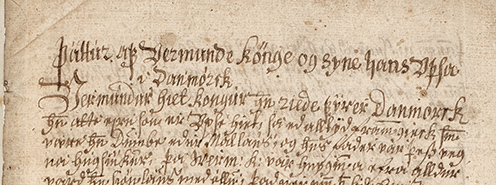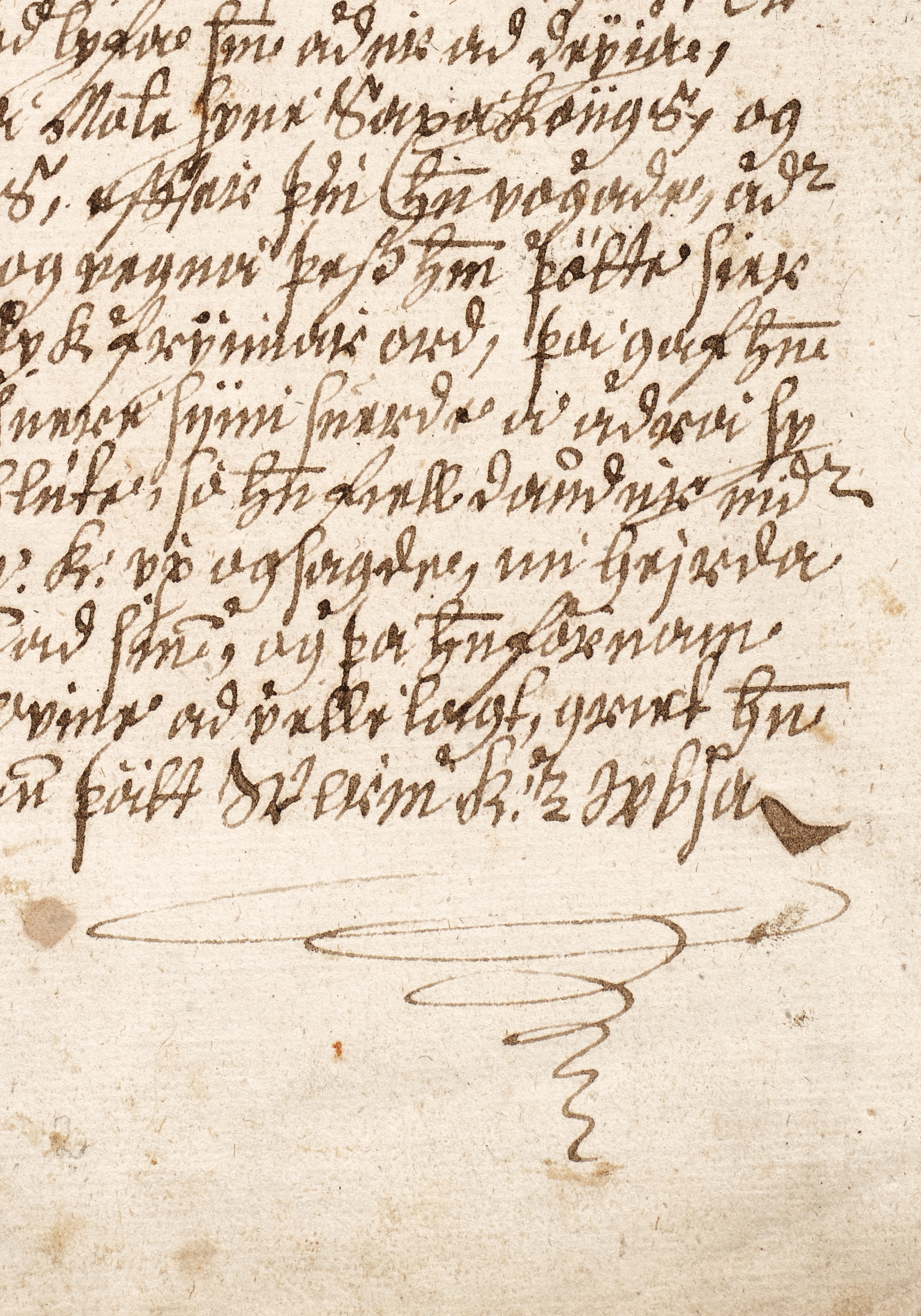Vermundar þáttur og Upsa (The Tale of Vermundur and Upsi) in AM 409 fol.
This short tale about a king and his heroic son, written on only two leaves of paper, is not only interesting due to its literary content. The transmission of the narrative and the several layers of translations which lie behind this text represent a fascinating case of cultural continuity and reinvigoration during the renaissance of manuscript production in seventeenth-century Iceland.
In Beowulf, one of the most significant pieces of Old English literature (written at some point before AD 1000), we get a glimpse of one of the ancient kings of the Angles:
…forðam Offa wæs
geofum ond guðum, garcene man,
wide geweorðod, wisdome heold
eðel sinne; þonon Eomer woc
hæleðum to helpe, Hemminges mæg,
nefa Garmundes, niða cræftig.
(ll. 1957–1962; Fulk et al. 2009: 66)
Indeed Offa, a spear-bold man, was widely honoured for gifts and battles; he held his homeland with wisdom. Thence sprang Eomer, to be a help to heroes–a kinsman of Hemming, grandson of Garmund, skillful in conflicts.
(Swanton 1997: 127–29)
This Offa, who shared his name with his famed descendant Offa of Mercia, is also mentioned in another Old English poem, Widsith or “Far-Journey”, as having won a great kingdom through battle. These brief references all seem to point to knowledge in the British Isles of a story comparable to that of the great champion Uffo, son of Wermundus, as it is also told in Saxo Grammaticus’ Gesta Danorum (Friis-Jensen & Fisher 2015: I,234–43) and Sven Aggesen’s Brevis Historia Regum Dacie (Christansen 1992: 50–54) (both from late twelfth-century Denmark). Indeed, it is the same narrative, which, in a testament to its longevity, is retold in the humble pair of seventeenth-century leaves which bear the shelfmark AM 409 fol.
The unexpected hero and the single combat
The narrative’s popularity over such an extended period can probably be attributed to its adoption of two of the most audience-pleasing tropes of heroic literature: the unexpected hero and the single combat. Upsi (as Offa/Uffo is called in the Icelandic version) is mute and apparently unequipped and incapable to succeed his father as king (a variation on what in many sagas is called the kolbítr-motif). But he surprises everyone by rising to the occasion when the kingdom is threatened by Saxon emissaries. A single combat (of sorts, there are actually two Saxons againt Upsi) takes place: this narrative strategy allows the intensity of international war to be condensed onto two (or more) individuals, heightening the audience’s ability to engage through its reduced focus. Both of these motifs combine in a dramatically novel way here: Vermundur (the Garmund of Beowulf and Wermundus of Saxo) is blind, and so when the single combat takes place he fearfully misinterprets the snick-snack of the swords to be the sound of his son being hacked to pieces.
Manuscript copying in 17th century Iceland
AM 409 fol. is the oldest surviving Icelandic witness of this tale as an independent story (brief descriptions appear earlier in the context of annals). It bears the title of Þáttur af Vermundi kongi og syni hans Upsa í Danmörk (“Short story of King Vermundur and his son Upsi in Denmark”) and stands unaccompanied by other texts in the manuscript, which, as mentioned, consists of only two leaves. It is possible that it was previously part of a larger codex which may have been divided up after it came into Árni Magnússon’s possession. Of its earlier history, Kristian Kålund says that AM 409 fol. was “skr. af præsten Þorleifur Clausson (?)” (“written by the priest Þorleifur Kláusson (?)”) and dates it to “17. århs slutn.” (“the end of the seventeenth century”). Despite Kålund’s bracketed interrogative, the identification seems satisfactory based on comparison with other manuscripts. Þorleifur Kláusson (1627–1699) was educated at Skálholt and worked for Bishop Brynjólfur Sveinsson (1605–1675), before becoming a parish priest in 1660 at Útskálar in south-west Iceland.
It seems thus that this short story was copied as part of the renaissance in manuscript production which took place in the middle of the seventeenth century in Iceland. Despite appearances however, this is not a copy of a traditional Old Norse saga passed down through generations of Icelanders. Rather it is an almost verbatim translation of Anders Sørensen Vedel’s 1575 Danish translation of the Gesta Danorum. Manuscript copying at and around Skálholt was in many ways inspired by Danish scholars’ desire to gain access to early Icelandic texts preserving details about their ancient history: is it possible that this translation was perhaps made with the intention of passing it off as a medieval saga which would corroborate Saxo’s twelfth-century Latin account? If not, then why send such a manuscript back to Denmark so shortly after its having first been translated out of Danish?
A curious journey of transmission and translation
As an addendum to this winding path of transmission, it may be noted that a copy of AM 409 fol. seems to have been preserved in KB Add. 15 (kept at the Royal Library in Copenhagen). The latter was written in the eighteenth century, and Kålund (1900: 434) identifies the scribe as Jon Mortenssön (or Jón Marteinsson, 1711–1771), who became a stipendarius at the Arnamagnæan Collection in 1742 and earned a living by producing transcriptions of texts, such as those found in Arnamagnæan manuscripts and the Royal Library (Bjarni Jónsson 1949: 77). Curiously, in the manuscript, after the Old Norse text, there is a Danish translation in the same hand under the title “kort fortælling af kong Vermund og hans son Upse i Danmark.” Thus we have a heroic Germanic legend from the early Middle Ages turned into a Latin text in the high Middle Ages translated into Danish on the heels of the Renaissance, then translated into Icelandic and finally back into Danish during the Enlightenment. Quite a journey!
Contact
 Philip Thomas Lavender is postdoc at The Arnamagnean Collection.
Philip Thomas Lavender is postdoc at The Arnamagnean Collection.
Phone: +45 35 33 38 96
plavender@hum.ku.dk
Bibliography
Bjarni Jónsson. Íslenzkir hafnarstúdentar. Akureyri: Bókútgáfan Akureyri, 1949.
Christiansen, Eric, trans. The Works of Sven Aggesen, Twelfth-Century Danish Historian. London: Viking Society, 1992.
Friis-Jensen, Karsten, ed., & Fisher, Peter, trans. Saxo Grammaticus: Gesta Danorum – The History of the Danes, 2 vols. Oxford: Clarendon Press, 2015.
Fulk, R.D, Bjork, Robert E. & Niles, John D., eds. Klæber’s Beowulf. Fourth Edition. Toronto: University of Toronto Press, 2009.
Kålund, Kristian. Katalog over de oldnordiske-islandske håndskrifter i det store kongelige bibliotek. Copenhagen: Gyldendal, 1900.
Swanton, Michael, ed. & trans. Beowulf. Revised Edition, edited with an introduction, notes and a new prose translation. Manchester: Manchester University Press, 1997.


